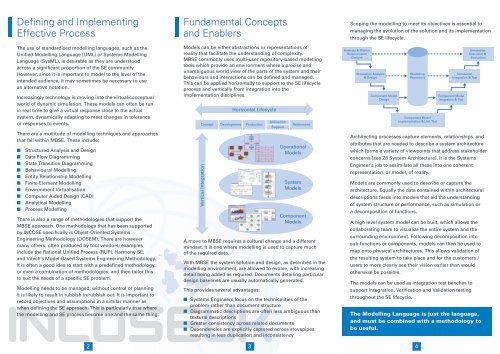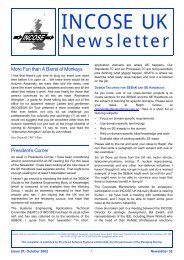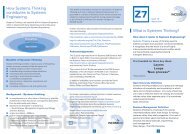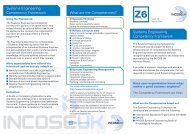Open - INCOSE UK Chapter
Open - INCOSE UK Chapter
Open - INCOSE UK Chapter
Create successful ePaper yourself
Turn your PDF publications into a flip-book with our unique Google optimized e-Paper software.
Defining and Implementing<br />
Effective Process<br />
Fundamental Concepts<br />
and Enablers<br />
Scoping the modelling to meet its objectives is essential to<br />
managing the evolution of the solution and its implementation<br />
through the SE lifecycle.<br />
The use of standardised modelling languages, such as the<br />
Unified Modelling Language (UML) or Systems Modelling<br />
Language (SysML), is desirable as they are understood<br />
across a significant proportion of the SE community.<br />
However, since it is important to model to the level of the<br />
intended audience, it may sometimes be necessary to use<br />
an alternative notation.<br />
Increasingly technology is moving into the virtual/conceptual<br />
world of dynamic simulation. These models can often be run<br />
in real time to give a virtual response close to the actual<br />
system, dynamically adapting to meet changes in tolerance<br />
or responses to events.<br />
There are a multitude of modelling techniques and approaches<br />
that fall within MBSE. These include:<br />
■ Structured Analysis and Design<br />
■ Data Flow Diagramming<br />
■ State Transition Diagramming<br />
■ Behavioural Modelling<br />
■ Entity Relationship Modelling<br />
■ Finite Element Modelling<br />
■ Environment Virtualisation<br />
■ Computer Aided Design (CAD)<br />
■ Analytical Modelling<br />
■ Process Modelling<br />
There is also a range of methodologies that support the<br />
MBSE approach. One methodology that has been supported<br />
by <strong>INCOSE</strong> specifically is Object-Oriented Systems<br />
Engineering Methodology (OOSEM). There are however<br />
many others, often produced by tool vendors; examples<br />
include the Rational Unified Process (RUP), Harmony SE,<br />
and Vitech’s Model-Based Systems Engineering Methodology.<br />
It is often a good idea to start with a predefined methodology,<br />
or even a combination of methodologies, and then tailor this<br />
to suit the needs of a specific SE problem.<br />
Modelling needs to be managed; without control or planning<br />
it is likely to result in rubbish in/rubbish out. It is important to<br />
record objectives and assumptions in a similar manner as<br />
when defining the SE approach. This is particularly true where<br />
the modelling and SE process become one and the same thing.<br />
<strong>INCOSE</strong><strong>UK</strong>3<br />
2<br />
Models can be either abstractions or representations of<br />
reality that facilitate the understanding of complexity.<br />
MBSE commonly uses multi-user repository-based modelling<br />
tools which provide an environment where a precise and<br />
unambiguous world view of the parts of the system and their<br />
behaviours and interactions can be defined and managed.<br />
This can be applied horizontally to support to the SE lifecycle<br />
process and vertically from integration into the<br />
implementation disciplines.<br />
Horizontal Lifecycle<br />
Utilisation<br />
Concept Development Production<br />
Support<br />
Retirement<br />
Vertical Integration<br />
A move to MBSE requires a cultural change and a different<br />
mindset. It is one where modelling is used to capture much<br />
of the required data.<br />
With MBSE the system solution and design, as described in the<br />
modelling environment, are allowed to evolve, with increasing<br />
detail being added as required. Documents detailing particular<br />
design baselines are usually automatically generated.<br />
This provides several advantages:<br />
Operational<br />
Models<br />
System<br />
Models<br />
Component<br />
Models<br />
■ Systems Engineers focus on the technicalities of the<br />
problem rather than document structure<br />
■ Diagrammatic descriptions are often less ambiguous than<br />
textural descriptions<br />
■ Greater consistency across related documents<br />
■ Dependencies are explicitly captured across stovepipes<br />
resulting in less duplication and inconsistency<br />
Analysis & Metrics<br />
Requirements<br />
Capture<br />
Simulation Analysis<br />
& Design<br />
Component Model<br />
Design<br />
Architecting processes capture elements, relationships, and<br />
attributes that are needed to describe a system architecture<br />
which forms a variety of viewpoints that address stakeholder<br />
concerns [see Z8 System Architecture]. It is the Systems<br />
Engineer’s job to assimilate all these into one coherent<br />
representation, or model, of reality.<br />
Models are commonly used to describe or capture the<br />
architecture. Equally the data contained within architectural<br />
descriptions feeds into models that aid the understanding<br />
of system structure or performance, such as simulation or<br />
a decomposition of functions.<br />
A high level system model can be built, which allows the<br />
collaborating team to visualize the entire system and the<br />
surrounding environment. Following decomposition into<br />
sub-functions or components, models can then be used to<br />
map onto physical architectures. This allows validation of<br />
the resulting system to take place and for the customers /<br />
users to more clearly see their vision earlier than would<br />
otherwise be possible.<br />
The models can be used as integration test benches to<br />
support Integration, Verification and Validation testing<br />
throughout the SE lifecycle.<br />
Modelling<br />
Repository<br />
Component Model<br />
Implementation & Unit Test<br />
The Modelling Language is just the language,<br />
and must be combined with a methodology to<br />
be useful.<br />
4<br />
Simulation<br />
Execution &<br />
Evaluation<br />
Simulation<br />
Integration & Test<br />
Component Model<br />
Intrgration & Test










